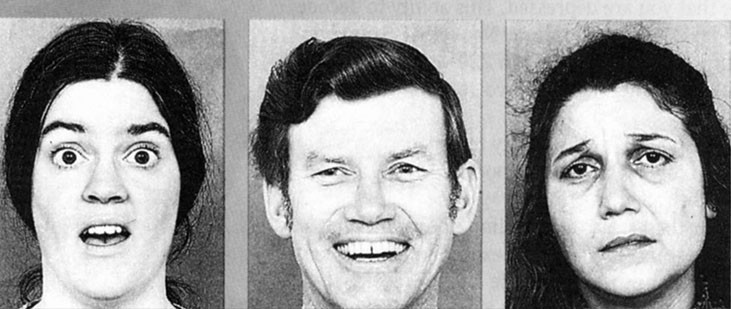By Julie Beck | The Atlantic | February 24, 2015
When Paul Ekman was a grad student in the 1950s, psychologists were mostly ignoring emotions. Most psychology research at the time was focused on behaviorism—classical conditioning and the like. Silvan Tomkins was the one other person Ekman knew of who was studying emotions, and he’d done a little work on facial expressions that Ekman saw as extremely promising.
“To me it was obvious,” Ekman says. “There’s gold in those hills; I have to find a way to mine it.”
For his first cross-cultural studies in the 1960s, he traveled around the U.S., Chile, Argentina, and Brazil. In each location, he showed people photos of different facial expressions and asked them to match the images with six different emotions: happiness, sadness, anger, surprise, fear, and disgust. “There was very high agreement,” Ekman says. People tended to match smiling faces with “happiness,” furrow-browed, tight-lipped faces with “anger,” and so on.
But these responses could have been influenced by culture. The best way to test whether emotions were truly universal, he thought, would be to repeat his experiment in a totally remote society that hadn’t been exposed to Western media. So he planned a trip to Papua New Guinea, his confidence bolstered by films he’d seen of the island’s isolated cultures: “I never saw an expression I wasn’t familiar with in our culture,” he says.
Once there, he showed locals the same photos he’d shown his other research subjects. He gave them a choice between three photos and asked them to pick images that matched various stories (such as “this man’s child has just died”). Adult participants chose the expected emotion between 28 and 100 percent of the time, depending which photos they were choosing among. (The 28 percent was a bit of an outlier: That was when people had to choose between fear, surprise, and sadness. The next lowest rate was 48 percent.)
And so the six emotions used in Ekman’s studies came to be known as the “basic emotions” all humans recognize and experience. Some researchers now say there are fewer than six basic emotions, and some say there are more (Ekman himself has now scaled up to 21), but the idea remains the same: Emotions are biologically innate, universal to all humans, and displayed through facial expressions. Ekman, now a professor emeritus of psychology at the University of California, San Francisco, with his own company called The Paul Ekman Group, was named one of Time’s 100 most influential people in 2009, thanks to this work.
But despite the theory’s prominence, there are scientists who disagree, and the debate over the nature of emotion has been reinvigorated in recent years. While it would be easy to paint the argument as two-sided—pro-universality versus anti-universality, or Ekman’s cronies versus his critics—I found that everyone I spoke to for this article thinks about emotion a little differently.
Read the full article here, featuring CLBB Faculty Lisa Feldman Barrett’s work on emotion.



